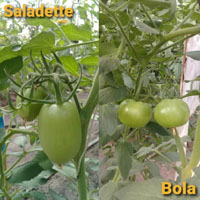Potential elicitors on secondary metabolite production and antioxidant defence activity of two tomato (Solanum lycopersicum L.) varieties

Accepted: 7 June 2021
PDF: 607
All claims expressed in this article are solely those of the authors and do not necessarily represent those of their affiliated organizations, or those of the publisher, the editors and the reviewers. Any product that may be evaluated in this article or claim that may be made by its manufacturer is not guaranteed or endorsed by the publisher.
Plants protect themselves, after pathogen attack, through the passive and active defence mechanisms. The treatment of plants with various agents, including cell wall fragments, plant extracts, and synthetic chemicals, can induce resistance to subsequent pathogen attack both locally and systemically. In view of the capability of phytochemicals compounds found in fruits and vegetables with different proven health benefits to consumers, there are different strategies to enhance the concentration of these compounds, among which the use of elicitors. Elicitation has been used to trigger different defence responses in plants, which lead to different mechanisms, such as activation of enzymes related with secondary metabolism. In this study we investigated the effects of elicitors (Activane®, Micobiol®, Stemicol® in doses of 1.8 g L–1, 3 m L–1 and 2.5 g·L–1) on the activity of two enzymes (polyphenoloxydase and peroxidase) in leaves as well as on the bioactive content (DPPH scavenging activity, total phenol and total flavonoid content) in fruits of Solanum lycopersicum L. The elicitors studied affected the production of enzyme and antioxidant activities in tomato, though showed a variable influence on the production of total phenolic and flavonoid content in tomato fruits. In general, the elicitors are able to increase polyphenoloxydase activity in leaves and phytochemical properties in fruits, with a significant negative correlation between the DPPH scavenging activity, total phenolic and flavonoids. These findings provide positive directions for the possible use of these elicitors in tomato (‘Bola’ and ‘Saladette’) production in greenhouse.
Highlights
- Elicitors increase the enzymatic activity of PPO in tomato leaves.
- The production of total phenolic contents and flavonoids depends on type of elicitors.
- No effects on the peroxidase content of the tomato leaves.
- The antioxidant capacity of the aqueous fruits extract showed a significant difference (P=0.05) between the treatments in the Saladette variety.
- Positive relationship between total phenolic contents and flavonoids.
How to Cite

This work is licensed under a Creative Commons Attribution-NonCommercial 4.0 International License.
PAGEPress has chosen to apply the Creative Commons Attribution NonCommercial 4.0 International License (CC BY-NC 4.0) to all manuscripts to be published.

 https://doi.org/10.4081/ija.2021.1883
https://doi.org/10.4081/ija.2021.1883



